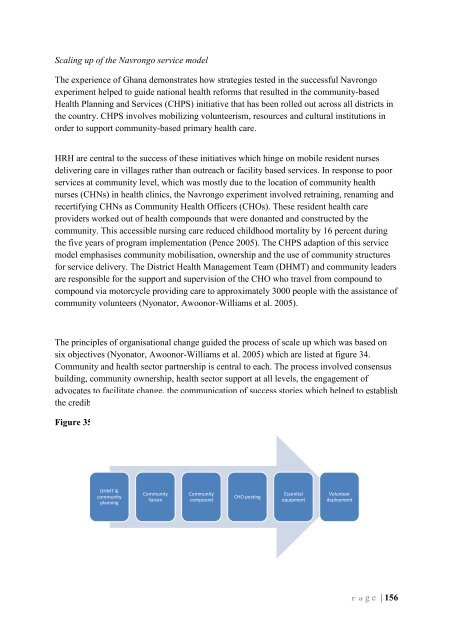Human Resources for Health in Maternal, Neonatal and - HRH ...
Human Resources for Health in Maternal, Neonatal and - HRH ...
Human Resources for Health in Maternal, Neonatal and - HRH ...
Create successful ePaper yourself
Turn your PDF publications into a flip-book with our unique Google optimized e-Paper software.
Scal<strong>in</strong>g up of the Navrongo service model<br />
The experience of Ghana demonstrates how strategies tested <strong>in</strong> the successful Navrongo<br />
experiment helped to guide national health re<strong>for</strong>ms that resulted <strong>in</strong> the community-based<br />
<strong>Health</strong> Plann<strong>in</strong>g <strong>and</strong> Services (CHPS) <strong>in</strong>itiative that has been rolled out across all districts <strong>in</strong><br />
the country. CHPS <strong>in</strong>volves mobiliz<strong>in</strong>g volunteerism, resources <strong>and</strong> cultural <strong>in</strong>stitutions <strong>in</strong><br />
order to support community-based primary health care.<br />
<strong>HRH</strong> are central to the success of these <strong>in</strong>itiatives which h<strong>in</strong>ge on mobile resident nurses<br />
deliver<strong>in</strong>g care <strong>in</strong> villages rather than outreach or facility based services. In response to poor<br />
services at community level, which was mostly due to the location of community health<br />
nurses (CHNs) <strong>in</strong> health cl<strong>in</strong>ics, the Navrongo experiment <strong>in</strong>volved retra<strong>in</strong><strong>in</strong>g, renam<strong>in</strong>g <strong>and</strong><br />
recertify<strong>in</strong>g CHNs as Community <strong>Health</strong> Officers (CHOs). These resident health care<br />
providers worked out of health compounds that were donanted <strong>and</strong> constructed by the<br />
community. This accessible nurs<strong>in</strong>g care reduced childhood mortality by 16 percent dur<strong>in</strong>g<br />
the five years of program implementation (Pence 2005). The CHPS adaption of this service<br />
model emphasises community mobilisation, ownership <strong>and</strong> the use of community structures<br />
<strong>for</strong> service delivery. The District <strong>Health</strong> Management Team (DHMT) <strong>and</strong> community leaders<br />
are responsible <strong>for</strong> the support <strong>and</strong> supervision of the CHO who travel from compound to<br />
compound via motorcycle provid<strong>in</strong>g care to approximately 3000 people with the assistance of<br />
community volunteers (Nyonator, Awoonor-Williams et al. 2005).<br />
The pr<strong>in</strong>ciples of organisational change guided the process of scale up which was based on<br />
six objectives (Nyonator, Awoonor-Williams et al. 2005) which are listed at figure 34.<br />
Community <strong>and</strong> health sector partnership is central to each. The process <strong>in</strong>volved consensus<br />
build<strong>in</strong>g, community ownership, health sector support at all levels, the engagement of<br />
advocates to facilitate change, the communication of success stories which helped to establish<br />
the credibility <strong>and</strong> feasibility of the <strong>in</strong>itiative.<br />
Figure 35 Key components of the CHPS <strong>in</strong>itiative<br />
DHMT &<br />
community<br />
plann<strong>in</strong>g<br />
Community<br />
liaison<br />
Community<br />
compound<br />
CHO post<strong>in</strong>g<br />
Essential<br />
equipment<br />
Volunteer<br />
deployment<br />
P a g e | 156

















